The award recognizes the importance of teaching excellence among UofL instructors and offers individual recognition to those who explore new methods for fostering learning and improving teaching. Award winners each will receive a $500 cash award. The 2024 TILL Teaching Innovation Award will include innovations implemented during the 2022-23 and 2023-24 academic years.
TILL Teaching Innovation Award
The Delphi Center is pleased to invite applications for the 2024 TILL Teaching Innovation Award. This annual award honors the University of Louisville's outstanding instructors who demonstrate a commitment to student engagement and learning through their work on one or more innovative teaching practices.
The TILL Teaching Innovation Award highlights the TILL's goals of (1) implementation and promotion of evidence-based teaching practices and (2) fostering student engagement, learning, and success. Up to three instructors from any of UofL's campuses receive this award each year.
Application period is now closed.
Are you someone who successfully innovates in your teaching? Have you worked to engage students through creative methods or cutting-edge teaching practices? Have you experimented with a new teaching method and found it increased student learning? If so, please consider applying for the TILL Teaching Innovation Award.
Complete information, including award guidelines and requested application materials, is provided in the accordion tabs below.
-
 Award Description
Award Description -
 Award Criteria
Award CriteriaThe TILL Teaching Innovation Award Committee will evaluate the applications based on the strength of evidence of the following criteria:
- The application materials should provide sufficient evidence to demonstrate the significance and effectiveness of the nominee’s innovations.
- The application materials should provide a clear explanation of how the teaching innovation met a need or addressed a challenge in learning.
- Additional consideration will be given to applications who demonstrate the following:
- Creativity in the teaching innovation and/or its implementation
- Potential for other instructors to adopt the teaching strategy (or components of it) within and across diverse academic disciplines
- Extent the instructor has shared the innovation with others (SoTL research submissions or publications, internal or external presentations, etc.)
-
 Eligibility
Eligibility- The TILL Innovation Award is open to all eligible faculty, staff and graduate student instructors regardless of race/ethnicity, national origin, gender, social class, sexual orientation, age and disability.
- All UofL instructors of record (tenured, tenure-track, non-tenure track, part-time lecturers, and graduate student instructors) employed at UofL are eligible.
- After receiving a TILL Innovative Teaching Award, the instructor is not eligible to receive it again for five years.
-
 Notes and Exceptions
Notes and Exceptions- If a team applies rather than an individual, the team will split the cash award. The team should submit a single application and submit all CVs as a combined PDF.
Previous Winners
Learn about the teaching innovations developed and implemented by previous winners.
-
 2023 Teaching Innovation Award Winners
2023 Teaching Innovation Award WinnersShae Morgan
School of Medicine
For building and implementing Theta, a web-based simulator that allows students to practice hearing tests on their computers. Theta has been adopted by over 50% of the Doctor of Audiology program in the US.Staci Saner, Russell Farmer, Laura Weingartner and Gerard Rabalais
School of Medicine
For the development of the Questioning Aid for Rich Real-time Discussion (QARRD) that raised the complexity of clinical faculty’s discussion questions of their medical residents.Lucian Rothe and Jordan Gabbard
College of Arts and Sciences
For their use of VR headsets in the TILL to virtually transport German students to real-life spaces of German-speaking regions.Honorable Mentions:
Edna Ross and Deborah Yoder-Himes
College of Arts and Sciences
For their research into the systematic biases of Respondus Monitor and the simulation they developed for faculty to reveal the inherent biases of using this teaching tool.Zac Goldman
College of Business
For developing and launching the Cardinal Choice Assignment across the entire core curriculum on the Online MBA program.Benne Holwerda
College of Arts and Sciences
Raymond Chastain
College of Business
Breanna Ausbrooks
For documenting learning gains and lowering DFW rates in classes with flipped classroom pedagogy.
-
 2022 Teaching Innovation Award Winners
2022 Teaching Innovation Award WinnersNatalie Christian, PhD; Rachel Pigg, PhD; Mikus Abolins-Abols, PhD and Jeffery Masters, PhD
Department of Biology
College of Arts and Sciences
Teaching Innovation: Redesigning the Introductory Biology Laboratory Experience with Course-based Undergraduates Research Experiences (CUREs)Research shows that Course-based undergraduate research experiences (CUREs) are an excellent way to expose a greater number and diversity of students to authentic, inquiry-based research. These experiences lead to higher student retention in STEM, increased pursuit of careers in STEM, and higher academic self-efficacy. However, many CUREs are designed for upper-level courses, leaving out most students and failing to intervene when students are most at-risk for dropping a course or major.
The core purpose of their innovation was to redesign the introductory biology laboratory experience at the University of Louisville as a two-semester, sequential CURE. Students now conduct authentic research in molecular biology in their first semester and then connect their work to biodiversity and landscape ecology in their second semester.
Their teaching innovation models how authentic inquiry and research can be incorporated into the curriculum, even in large introductory courses. CUREs are typically part of specialized upper-level classes and scaling them to hundreds of students may be seen as a barrier in various disciplines – particularly in introductory-level STEM courses. These winners show that students can conduct authentic research if you scaffold their experience appropriately. Additionally, the tools that help scaffold the student experience in their CURE, such as improving group work with peer evaluation, or building rubrics and training students on how to use them to write better reports, can be widely implemented across many academic disciplines to build community and increase the class expectations’ clarity.
Danielle Franco, PhD
Department of Chemistry
College of Arts and Sciences
Teaching Innovation: Using Online Simulations and Virtual Reality to Teach ChemistryDr. Franco used online simulations and Virtual Reality (VR) to teach Introduction to Chemistry and General Chemistry courses in spring 2021, fall 2021 and spring 2022. VR is a powerful tool to help students to visualize and assimilate concepts, such as atomic structure, hybridized orbitals, and covalent bonds, in an innovative and engaging way. She recorded course content for asynchronous classes using 3D models in VR to explain chemistry concepts. In addition to the recordings, she created her own virtual content and workshops online, where collaborative learning assessments offered students a hands-on experience and practice by teaching each other the course content. Students signed up for groups according to the topics that they wanted to cover, and they collaborated at their own pace on the project.
Online students are unable to participate personally in class discussions when courses are asynchronous. Dr. Franco’s strategy is innovative because it uses a new technology (VR) not only to deliver content, but also to create a learning environment where the students are motivated to explore the available resources and teach each other.
Importantly, Dr. Franco used applications where students are not required to have an HMD (head mounted device, aka headset.) The app is available on smartphones and mobile devices, allowing interaction with the class even without a headset. Students can move objects, virtually walk around the classroom, communicate, and upload content. Her use of VR serves as a model for how instructors across content areas can embrace virtual and augmented reality tools.
David Johnson, PhD
Department of Health Management and Systems Sciences
School of Public Health and Information Sciences
Teaching Innovation: Operationalizing the Paul-Elder Model: Assessment and Evaluation Design to Develop Critical ThinkingDr. Johnson created the Intellectual Standards Rubric for Critical Thinking (ISRCT) from the principles of the Paul-Elder model for critical thinking. The rubric provides students with descriptions of behaviors that correlate with critical thinking and with examples of how those behaviors are demonstrated when completing an assignment. Once an assignment has been graded, students can click a link in their gradebook and review how they scored against each standard, all within a matter of seconds. When students are working on the next assignment, the record of their performance on prior assignments remains available to them through the Blackboard gradebook. This ensures that students remember which standards they demonstrated well and where they need to improve.
Because the ISRCT has been built into the digital structure of the course within Blackboard, a rubric evaluation report can be pulled to provide information about how well groups of students are performing against the standards measured by the ISRCT. The rubric evaluation report includes a frequency distribution, outlining the distribution of scores across each level of achievement. The ease of pulling the report in Blackboard means that the report can be run multiple times throughout the course allowing the instructor to track student progress. Progress can be tracked within a single course or across groups of students between sections and terms of the course.
This innovation is not discipline-specific and can be deployed within minutes in any course across the university, regardless of modality, discipline, or assignment design. Dr. Johnson has published and presented it nationally.
Daniela Terson de Paleville, PhD
Department of Health and Sport Sciences
College of Education and Human Development
Teaching Innovation: Flipped classroom, team-based active learning with immediate feedbackDr. Terson de Paleville uses team-based active learning to teach her anatomy and physiology course using a 4-step model including (1)preparation, (2) in-class readiness, (3) assurance testing and (4) application-focused exercises. While she has too many innovative assignments to describe in this short time, one example is an assignment on glucose metabolism. Each team was provided with a box comprised of Lego bricks, coins, small toys, magnets, and laminated labels to identify different stages and enzymes involved in glucose metabolism. After building a model of glucose metabolism, the students created a short video or podcast of approximately five minutes. Teams worked on the video during class and finished the following class. This work was actually done here in the Teaching Innovation Learning Lab and she has published it in the peer-reviewed journal Exercise Physiology. Other activities used in this class include interactive pre-recorded lectures, warm-up quizzing games using Quizlet Live and Poll Everywhere, Visible Body Anatomy Atlas, and the Visible Body Anatomy and Physiology.
A colleague who observed Dr. Terson de Paleville’s class had this to say about her teaching:
“During her team-based learning activities, Dr. Terson de Paleville continuously walked around the classroom as students worked in teams to apply the difficult concepts to practical situations. If a majority of the students/teams struggled with a particular concept, she said, “WE need to work on this.” She took the time to explain it in a different way that might be more helpful to the class. What stuck out to me most during my visit to her class was how engaged the students were. From the beginning of class until the end, students asked questions, actively participated, and genuinely seemed interested in the course material. When I left Dr. Terson de Paleville’s class, I was energized and excited about her methods and strategically thinking about how I could incorporate them into my own courses.”
-
 2021 Teaching Innovation Award Winners
2021 Teaching Innovation Award Winners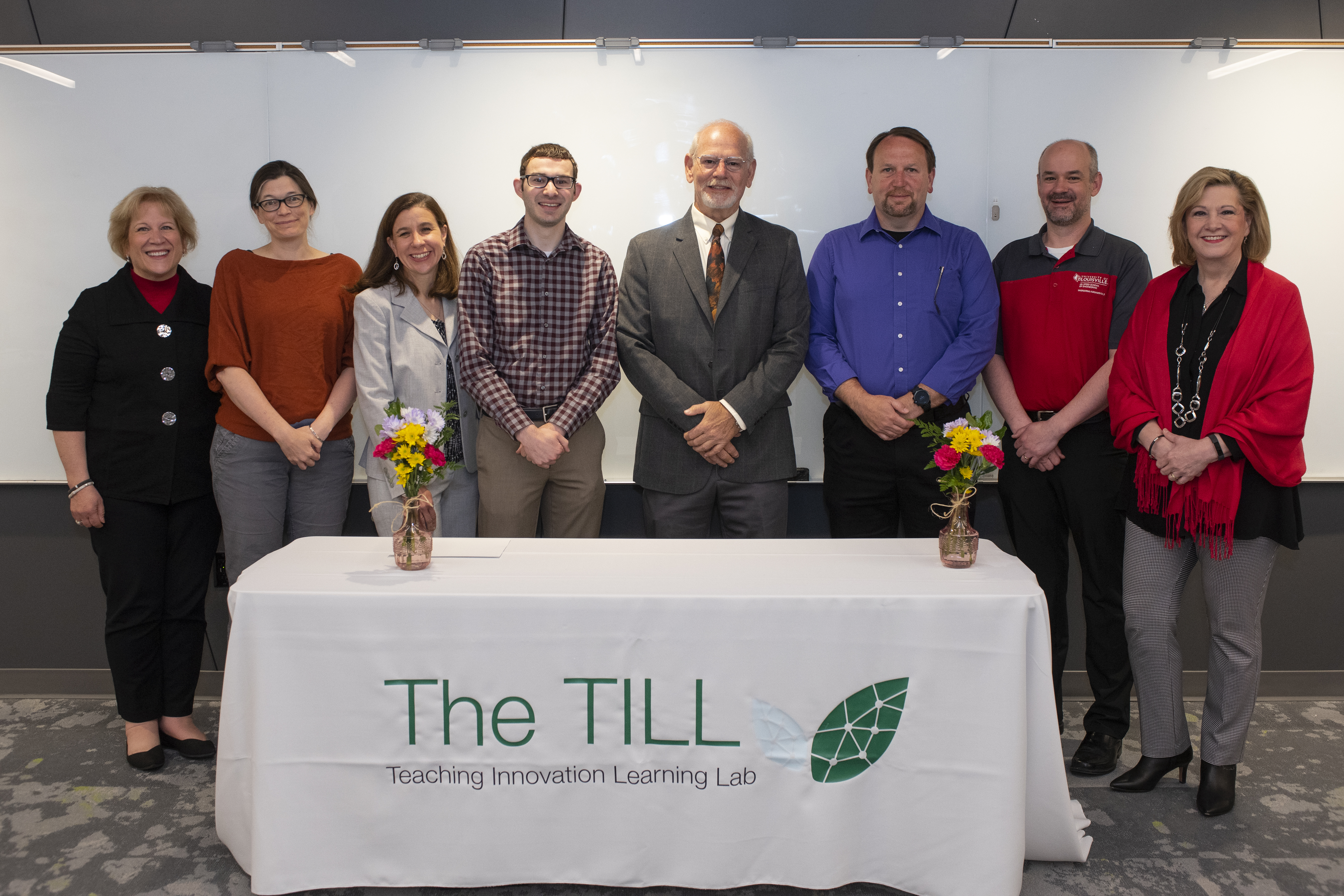
- Angela Storey
- Kathy Gosser
- Rachel Hopp
- Brian Robinson, James Lewis, Nicholas Hawkins, Gary Eisenmenger
Learn more about the 2021 TILL Teaching Innovation Award winners in this UofLNews.com story.
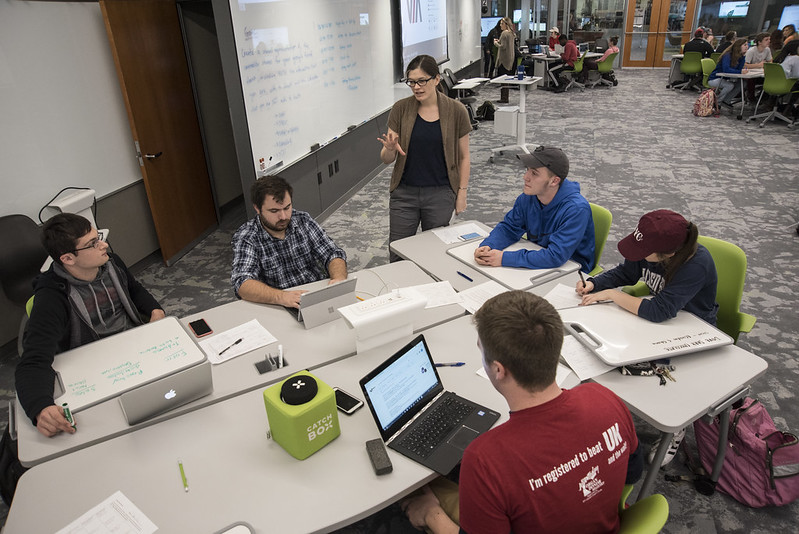
Angela Storey, PhD
Assistant Professor
Department of Anthropology
College of Arts and Sciences, University of LouisvilleRevitalizing ANTH 201 with a Peer Educator Program
About the Teaching Innovation
Using her background in active learning pedagogies and learner-centered teaching, Dr. Storey overhauled her GenEd course, ANTH 201, Introduction to Cultural Anthropology, and created the Peer Educator Program (PEP). The redesign revitalized the course. ANTH 201 is now a sought-after GenEd course that consistently fills each semester. Beginning in 2017 and running for eight semesters (even throughout the pandemic), the PEP has had 40 participants from 22 majors as of fall 2020.
The PEP is centered on a small, one-credit course, ANTH 430, Practicum in Anthropology Education. Students enrolled in this class are called Peer Educators and are taught active learning pedagogy and curriculum development. They design, create and lead “bonus sessions” for ANTH 201 students without Storey present. The course not only expands their knowledge of anthropology, it also helps them grow in the practice of teaching and in the process of teaching each other. For the ANTH 201 students, the bonus sessions led by the Peer Educators make learning fun and engaging and help students connect with one another.
The PEP is being considered by other departments across the university to increase active learning in the classroom. As one Peer Educator shared, “This focus on and critical engagement with active learning pedagogy allowed us to deepen our understanding of the course concepts and better serve the 201 students by designing lesson plans around evidence-based techniques that foster real, durable learning.”
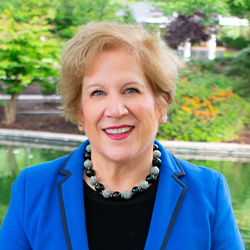
Kathy Gosser, PhD
Assistant Professor and Director of Franchise
Management
Management & Entrepreneurship
College of Business, University of LouisvilleUsing Podcasts to Increase Student Engagement
About the Teaching Innovation
When Dr. Gosser found that most of her students were not viewing the lectures in her Management 301 course, she knew something needed to change. With her background in management and organizational behavior, Gosser decided to create weekly podcasts full of real-life case studies and management examples. She bought a professional microphone, recorded in Panopto and uploaded her podcast instead of lectures. Students didn’t have to watch; they could just listen. She found that 80% of students were listening and 95% completed the episode – huge increases from 17% viewing and 65% watching her entire lectures.
Her students enjoyed being able to listen to course content on their own schedules while doing other things — at the gym, while making dinner, or just as a break being away from the computer. One student shared, “At first, I would watch the Panopto presentations but would not take away much from them. Once Dr. Gosser switched to the podcasts, my interest and knowledge level began to take off. Listening to someone tell real life stories and apply the concepts is always more interesting than just learning the textbook material.”
Gosser expanded her podcast to include weekly industry guests, mostly CEOs and top business leaders. Students benefit from hearing relevant content and seeing how it can be applied in real life.
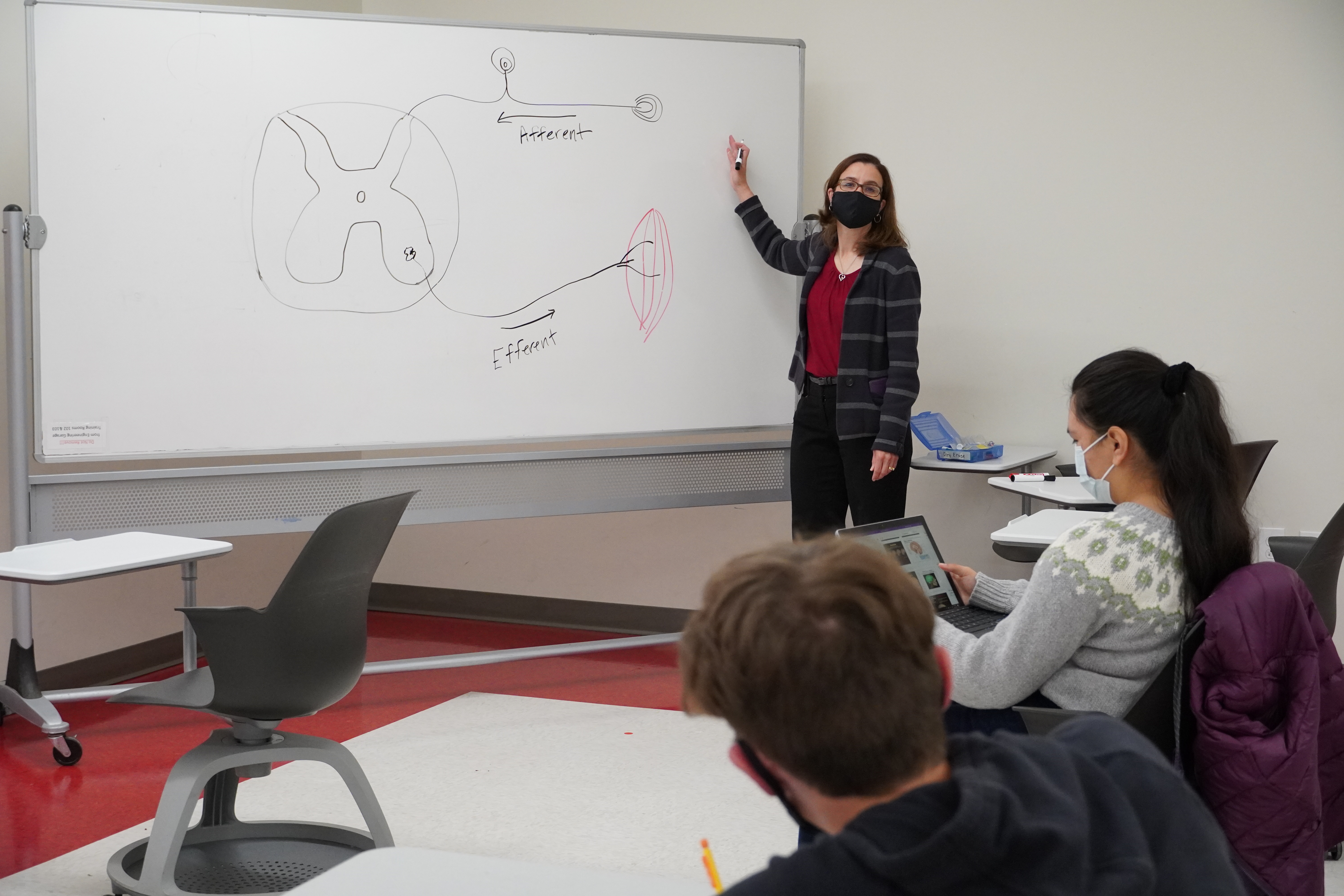
Rachel Hopp, PhD
Assistant Professor
Biology Department
College of Arts and Sciences, University of LouisvilleTaking Active Learning Online
About the Teaching Innovation
As the pandemic forced educators and students alike to get comfortable with online teaching, Dr. Hopp endeavored to make sure that her virtual classes were active learning spaces. In her face-to-face biology classes, Hopp used evidence-based pedagogy to good effect: she led a series of interrupted mini lectures (based on pre-assigned readings, homework, and videos) while students worked on activities in groups of 3 or 4. To develop and build the STEM concepts, students would work on an activity, gain feedback, and go back to working on an activity.
Hopp devised a way to translate this face-to-face approach to online learning. She wanted students to be able to stay connected to her AND the larger classroom (in case they had questions or got stuck) while being able to continuously talk in their small groups. By combining two web conferencing tools, she was able to keep her live, synchronous course consistently engaged for 50 to 75 minutes at a time. Hopp uses MS Teams and Bb Collaborate, but any two webinar services can be used, as long as there are breakout room options.
Hopp continually assesses course effectiveness by asking for student feedback and is agile with pedagogy. By asking how her students like to learn, she can identify learning outcomes that meet those preference and is able to offer activities and assessment focused on those specific outcomes.
-
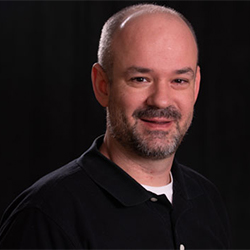
Brian Robinson, PhD
Assistant Professor
Department of Engineering Fundamentals
J.B. Speed School of Engineering, University of Louisville -
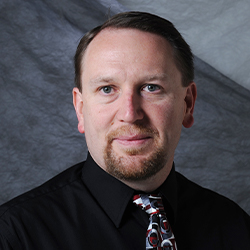
James Lewis, PhD
Associate Professor
Department of Engineering Fundamentals
J.B. Speed School of Engineering, University of Louisville -
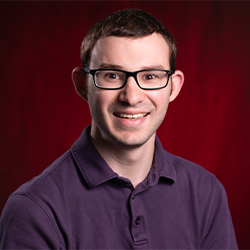
Nick Hawkins,
PhDAssistant Professor
Department of Engineering Fundamentals
J.B. Speed School of Engineering, University of Louisville -
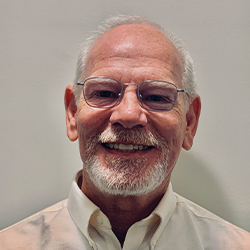
Gary Eisenmenger
Instructor
Department of Engineering Fundamentals
J.B. Speed School of Engineering, University of Louisville
Building an Online Makerspace
About the Teaching Innovation
In 2016, the J.B. Speed School of Engineering introduced two newly redesigned courses for first-year engineering students. ENGR 110, Engineering Methods, Tools, and Practice I focuses on fundamental engineering skills and is predominately classroom-based. ENGR 111, Engineering Methods, Tools, and Practice II is focused on application and integration of the fundamentals, and is conducted in a 15,000 sq. ft. makerspace called the Engineering Garage (EG). It relies heavily on teamwork and collaboration through problem-based, project-based and discovery-based coursework.
When the COVID-19 pandemic forced ENGR 110 and 111 to move to remote delivery, instructors sought to retain a heavy focus on teamwork and decided to implement Classroom Response Systems (CRS) since they are proven to increase active learning.
Class was conducted using MS Teams and CRS methodology, primarily Mentimeter, was implemented. A CRS allows students to respond in real-time to questions on a screen. It has been shown to improve student attention, engagement, and attendance, while stimulating discussion and providing feedback to students and instructors.
Remote design challenges were also implemented. Students submitted iterations of design files which were printed and tested in the EG by Instructors/TAs. Instructors/TAs provided feedback, including test videos, via channels in MS Teams so the entire class could learn from it.